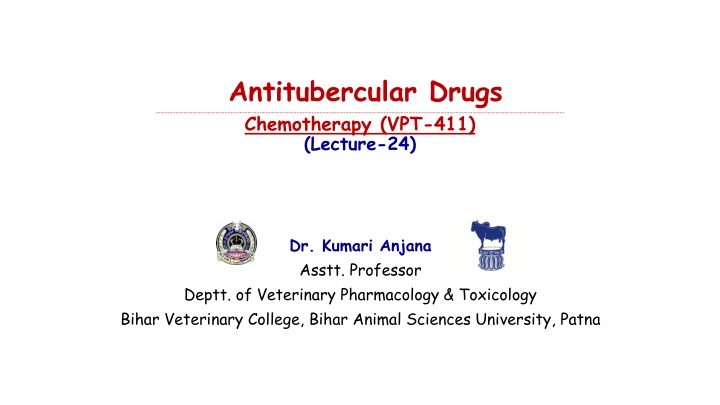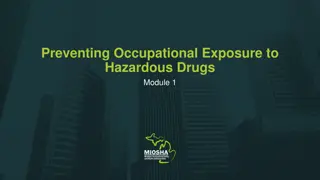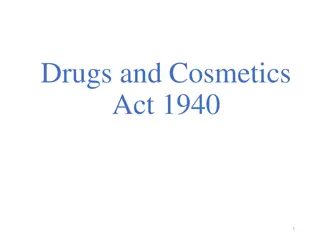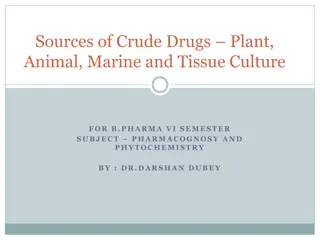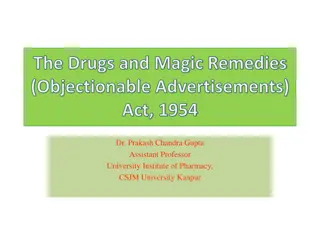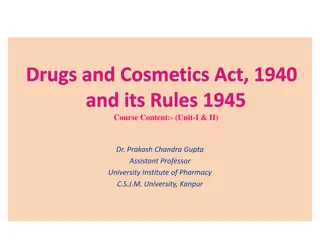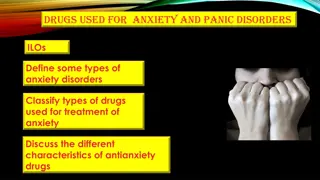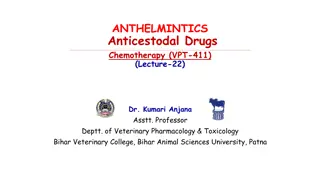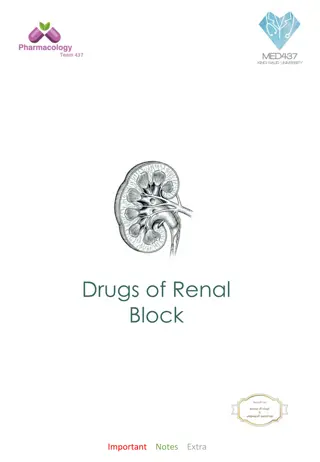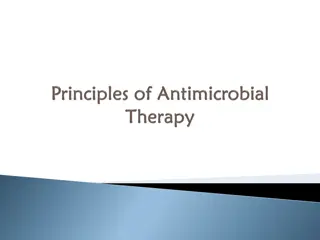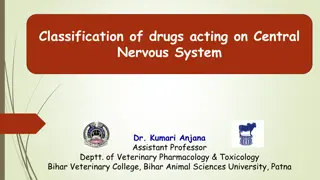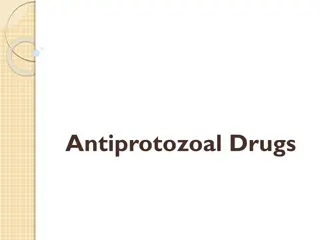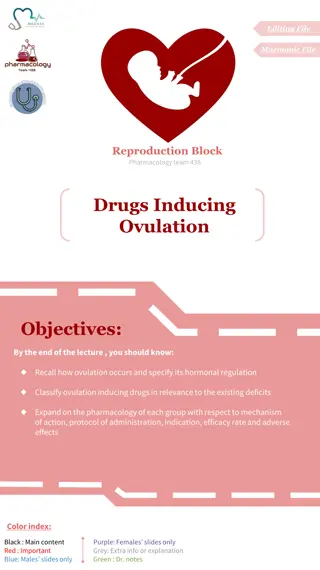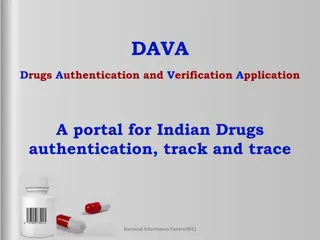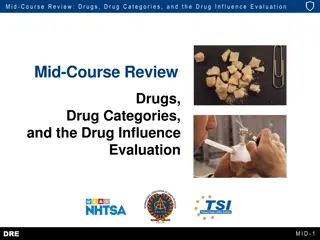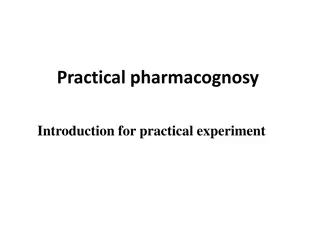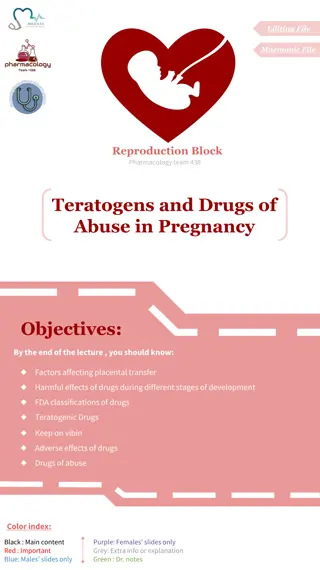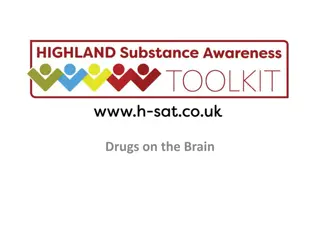Overview of Antitubercular Drugs: Introduction, Classification, and Applications
Tuberculosis is a chronic granulomatous disease caused by Mycobacterium bovis in ruminants and Mycobacterium avium in dogs and pigs. These bacteria have a unique waxy appearance due to their cell wall composition, providing a shield against pharmacological compounds. Antitubercular drugs play a crucial role in treating tuberculosis, classified based on their efficacy and toxicity. First-line drugs include Streptomycin, Isoniazid, Rifampicin, Ethambutol, Pyrazinamide, and Thiacetazone, while second-line drugs like Fluoroquinolones are used as reserve options. Understanding the classification and action of these drugs is essential for effective tuberculosis treatment.
Download Presentation

Please find below an Image/Link to download the presentation.
The content on the website is provided AS IS for your information and personal use only. It may not be sold, licensed, or shared on other websites without obtaining consent from the author.If you encounter any issues during the download, it is possible that the publisher has removed the file from their server.
You are allowed to download the files provided on this website for personal or commercial use, subject to the condition that they are used lawfully. All files are the property of their respective owners.
The content on the website is provided AS IS for your information and personal use only. It may not be sold, licensed, or shared on other websites without obtaining consent from the author.
E N D
Presentation Transcript
Antitubercular Drugs Chemotherapy (VPT-411) (Lecture-24) Dr. Kumari Anjana Asstt. Professor Deptt. of Veterinary Pharmacology & Toxicology Bihar Veterinary College, Bihar Animal Sciences University, Patna
Content of the chapter Antitubercular Drugs Introduction, classification spectrum of activity MOA Applications Side effects
Introduction Tuberculosis :chronic granulomatous disease. Mycobacterium bovis -- Ruminants. M. bovis and M. avium -- Dog. M. avium -- Pig. Sheep and horse are rarely affected.
Introduction contd Mycobacterium from the Greek word "mycos," refers to Mycobacteria's waxy appearance, which is due to the composition of their cell walls. More than 60% of the cell wall is lipid, mainly mycolic acids. This extraordinary shield prevents many pharmacological compounds from getting to the bacterial cell membrane or inside the cytosol. Another barrier is the property of some of the bacilli to hide inside the patient's themselves with an extra physicochemical barrier that antimicrobial agents must cross to be effective. cells, thereby surrounding waxy appearance of Mycobacteria Source : Google image
Classification These drugs have high antitubercular efficacy and low toxicity. Streptomycin, Isoniazid/isonicotinic acid hydrazide (INH or H), Rifampicin, Ethambutol (E), Pyrazinamide (PZ) and Thiacetazone (T). Paraaminosaliclic acid (PASA) First Generation Capreomycin (A), Cycloserine (C), Kanamycin (K), Ethionamde (Et). These drugs low anti TB efficacy, but relatively high toxicity. Second Generation Fluoroquinolones are also used under reserve category anti-TB drugs.
contd Some clinicians categorize the first and second line drugs as: Reserve Drugs: o Capreomycin (A), o Cycloserine (C), o Kanamycin (K), o Ethionamde (Et). Standard Drugs: oIsoniazid/isonicotinic acid hydrazide (INH or H), oRifampicin (R), oStreptomycin(S), oEthambutol (E), oPyrazinamide (PZ) and oThiacetazone (T).
contd Basing on the Antibacterial Action: Bactericidal: oIsoniazid/isonicotinic acid hydrazide (INH or H), oRifampicin (R), oStreptomycin(S), oPyrazinamide (PZ) and oCapreomycin (A), o Kanamycin (K), oCycloserine (C) and, oFluoroquinolones. Bacteriostatic: o Ethionamde (Et). o Ethambutol (E), o Thiacetazone (T). o Paraaminosalicylic acid (PASA)
General consideration for Treatment of TB Treatment of TB includes use of combination therapy; to avoid emergence of resistance in tubercular bacilli. In general the first-line (standard) drugs are to be used. The second-line (reserve) drugs are to be considered: owhen the bacilli become resistant to first-line drugs oor when the first-line drugs are to be discontinued due to appearance of adverse reactions.
The effective antitubercular combinations include: oStarting Phase: Daily dosing for2-3 months. oINH(H), oR, oPZ and oE or S: oContinuation Phase: Daily dosing for about 6 months. oH, oR or H,E. Thus anti-TB therapy extends up to a total duration of 8 or 9 months.
Isoniazid Isoniazid is chemically related to MAO inhibitor iproniazid. It posses bacteriostatic and bactericidal property. Well absorbed from GIT. Easily penetrates into caseous tubercular lesions and also readily taken up by TB bacilli. MOA:Exerts bactericidal effect oby inhibiting the synthesis of mycolic acids (essential cell wall constituents in Mycobacterium) and oalso causing damage to cell membrane by inhibiting phospholipids synthesis.
Resistance: oIf INH is given alone, after 2-3 months an apparent resistance emerges. oMechanism of resistance is attributed to failure of the drug being taken by organism. Adverse effect: oIts prolonged use may cause neurotoxicity (Peripheral neuritis - neurological manifestations such as paresthesis, numbness, mental disturbances). oThese are due to interference with utilization of pyridoxine (due to formation of pyridoxal-hydrazone complex) and its increased excretion in urine. oPyridoxine given prophylactically (10 mg/day) prevents neurotoxicity even with higher doses.
Rifampicin It is a semisynthetic derivative of rifamycin B (Streptomyces mediterranei). It has bactericidal action on M. tuberculosis, M. para- tuberculosisand other subpopulations of TB bacilli. It acts best on slowly or intermittently dividing bacilli as well as on many atypical mycobacteria. Both extra and intracellular organisms are affected.
MOA: acts by inhibiting protein synthesis in mycobacteria by inactivating DNA-dependent RNA synthesis. One of the most effective anti-TB antibiotics; also effective against many other Gram negative or Gram positive bacteria, including Mycobacterium laprae. It imparts orange color to saliva, sputum, tears and sweat. Adverse effect: Hepatitis.
Ethionamde It is chemically related to INH (H). It is tuberculostatic drug acts on both extra and intracellular organisms. It is rapidly and widely distributed. It also diffuses in CSF at effective concentrations. It is excreted rapidly through urine, less than 1% is excreted unchanged.
Ethambutol Ethambutol (d-Ethambutol) possess selective tuberculostatic activity. is a commonly used anti-tubercular drug, When it is used in combination with Isoniazid and Pyrazinamide it has been found to hasten the rate of sputum conversion and prevent development of resistance in humans. MOA: Not fully understood but it has been found to inhibit arabinogalactan synthesis and to interfere with mycolic acid synthesis and cell wall formation; ineffective against other bacteria. It readily enters into RBC, where it serves as store depot. Adverse Reactions: Loss of visual acquity or colour vision due to optic neutritis.
Pyrazinamide It is chemically related to nicotinamde and thiosemicarbazones. It is ineffective against bovine TB bacilli. It is chemically similar to isoniazid. It is active against intracellularly located bacilli and in acidic medium, at pH 5 5.5. It is highly effective during the first 2 months of therapy when inflammatory changes are present.
Thiacetazone Thiacetazone is derivative of thiosemicarbazone. It is used orally along with Isoniazid as a substitute for Paraaminosalicylic acid. It is a tuberculostatic drug possess low efficacy. It is orally active, primarily excreted unchanged in urine with a half life of 12 hours. It is frequently used as combined tablet with isoniazid. Adverse effects-hepatitis, exfoliative dermatitis and rarely bone marrow depression.
Capreomycin Capreomycin is capreolus). a peptide antibiotic (Streptomyces Like streptomycin it causes renal damage and injury to VIII cranial nerve (deafness and ataxia). Not to be combined with S or K (synergistic toxicity).
Cycloserine A broad spectrum antibiotic, obtained from Streptomyces orchidaceus and also effective against many other bacteria. It is analogue of D-alanine, inhibits bacterial cell wall formation by preventing d-ala-d-ala dipeptide synthesis required for formation of NAMA pentapeptide (peptidoglycon). It is soluble in water and is stable in alkaline solution but destroyed when exposed to neutral or acidic pH. Highly diffusible in body fluids and tissues, concentrations in CSF correspond to plasma.
Streptomycin It was the first clinically useful anti- tubercular drug. It is an aminoglycoside Streptomyces griseus. It is tuberculocidal but less effective than Isoniazide & Rifampin. antibiotic obtained from It acts only on extracellular bacilli (poor penetration into cells).
Mechanism of Action : Inhibition of bacterial protein synthesis by binding with 30s subunit of bacterial ribosomes. After exposure to it sensitive bacteria becomes more permeable to ions, AA and proteins leak out followed by death. Kanamycin Kanamycin (Streptomyces kanamyceticus); should not be combined with S or A (synergistic toxicity).
Paraaminosalicylic acid (PAS) Paraaminosalicylic acid (PASA) exerts anti PABA activity like sulfonamides; has no antipyretic or analgesic or anti- inflammatory action of salicylic acid. It was introduced in 1946 on the basis of observed effects of salicylic acid on the metabolism of mycobacterium tuberculosis. Least active drugs, only delay the development of resistance. It is tuberculostatic drug active only on TB bacilli and not on other bacteria.
Mechanism of Action : Competitively inhibits an enzyme dihydropteroate synthetase analogues or antagonists of Para-aminobenzoic acid (PABA), leading to inhibition of synthesis of folic acid and subsequent metabolites resulting in tuberculostatic effect. PASA is not effective against sulphonamide sensitive organism and vice versa. as they are structural Selectivity for T.B. may be due to difference in the affinity of Folate synthatase of T.B.
Fluoroquinolones such as oCiprofloxacin, oOfloxacin and oSparfloxacin and Newer macrolides like oAzithromycin and oClarithromycin These drugs can be considered as second-line or reserve category.
Dosage of anti-TB drugs The dosage of anti-TB drugs in man: oIsoniazid: 5 (mg/kg/day). oRifampicin: 10 (mg/kg/day). oPyrazinamide: 25 (mg/kg/day). oEthambutol and Streptomycin: 15 (mg/kg/day).
Summary More than 60% of the cell wall is lipid, mainly mycolic acids. Treatment of TB includes use of combination therapy. Thus anti-TB therapy extends up to a total duration of 8 or 9 months. Rifampin imparts orange color to saliva, sputum, tears and sweat.
References B.K.Roy., Veterinary Pharmacology and Toxicology 2011, Kalyani Publication, pp -431-434. Tripathi K.D. , Essentials of medical pharmacology ,6th edition- 2008,Jaypee Brothers Medical Publishers, PP - 739-750. Prasad V. Vani. and Koley K.M., Synopsis of Veterinary Pharmacology and Toxicology 2006, Vahini Publications, pp-206-207.
